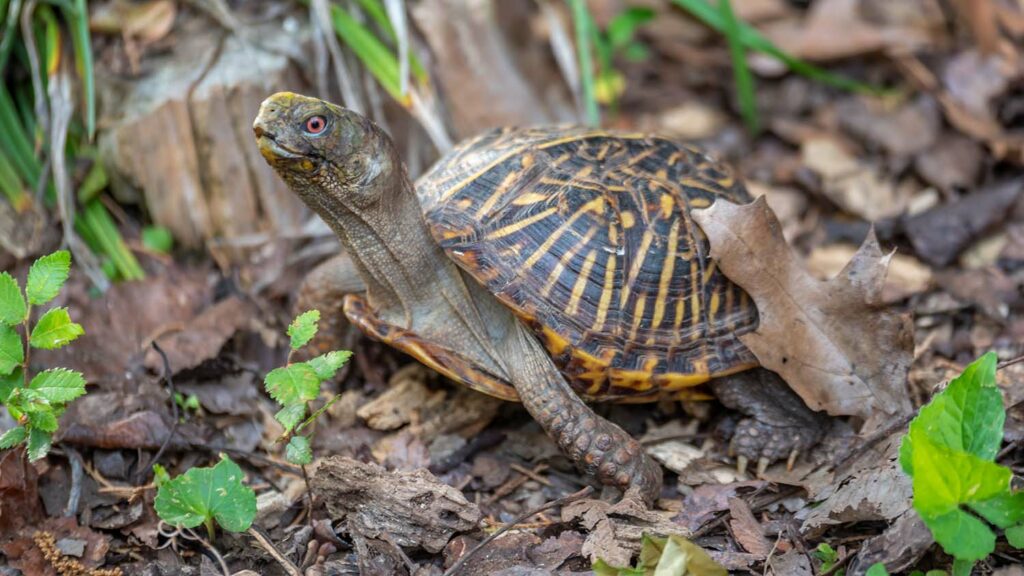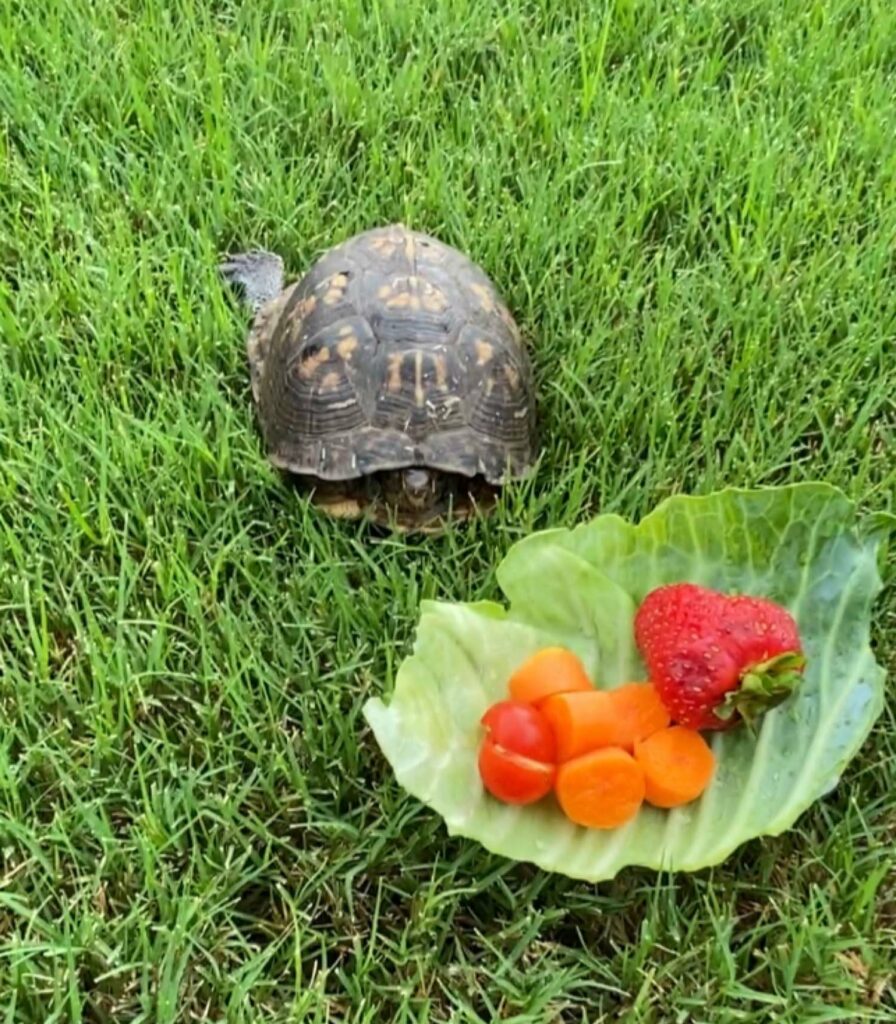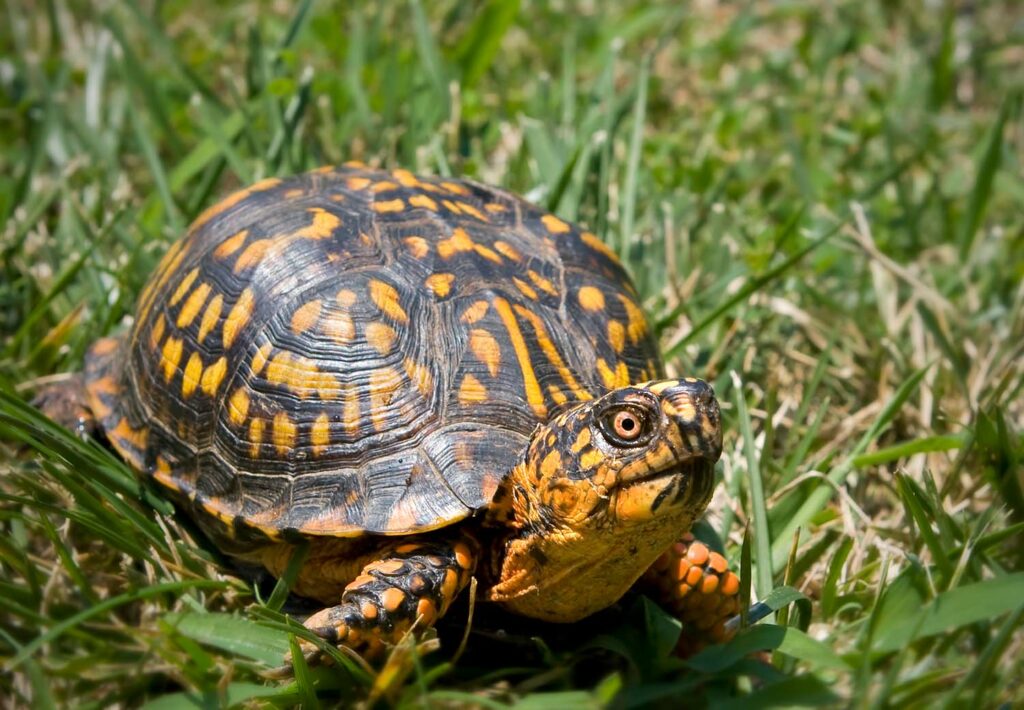One of the most important parts of keeping box turtles as pets is providing a proper diet that includes foods these turtles eat in the wild. Many of the things wild box turtles eat are not readily available in pet stores. But, because they are opportunistic eaters who are not fussy about their food, the answer to our question “what do box turtles eat?” is an easy find. And we have it below.

Quick Navigation
What do Box Turtles Eat in the Wild?
Box turtles are omnivorous that eat almost everything they can find. In the wild that includes earthworms, spiders, caterpillars, isopods, millipedes, or ants they find on the ground, but also berries, roots, flowers, or even eggs.

When it is wading or basking, wild box turtles will happily snack on crayfish, frogs, or fish. They also enjoy plant matter in their diet. Fallen fruits, preferably overripe or beginning to rot, are a favorite treat. When they find them, box turtles eat berries on low branches, flowers, grass, cacti, and mushrooms.
Box turtles are found from Maine to Michigan and from eastern Texas to Mexico’s Yucatan Peninsula. Because of this, the specific foods box turtles eat in the wild will vary depending upon the region and the season.
What do Box Turtles Eat as Pets?
As pets, box turtles should eat a highly varied diet that includes a combination of fresh vegetables (40%) and fruits (10%), mixed with low-fat protein (50%). A great meal for captive box turtles includes vegetables like carrots, squash, or sweet peppers, fruits like berries, or melons, and whole live foods like earthworms, waxworms, crickets, slugs, or snails.

While box turtles in captivity can be a bit pickier, it is easy to provide a pet box turtle diet that will keep your hard-shelled companion healthy and happy.
Captive box turtles live in a very different environment than wild box turtles. While they are safe from predators like raccoons and coyotes, they do not have easy access to many of the plants and insects that are part of their natural diet.
Because box turtles eat so many different things in the wild, a pet box turtle diet should feature plenty of variety. If you try feeding your pet box turtle the same food every day, it may start losing interest in its food.
Fruits and Vegetables
Plants you should make a part of your pet box turtle diet include:
- Colorful vegetables like carrots, squash, sweet peppers
- Berries, preferably overripe
- Melon with the rind
- Collard greens, mustard greens, dandelion, chard
- Green beans
- Flower petals like rose petals, hibiscus, and geraniums. (Be sure they have not been sprayed with pesticides or fertilizer!)
Animal Protein
Your pet box turtle is an omnivore and will need animal protein in addition to plants. Some animal proteins that can be part of a pet box turtle diet include:
- Eggs
- Beef heart
- Mealworms, waxworms, and superworms
- Cooked chicken
- Pinky mice
- Earthworms and nightcrawlers
- Crickets
Commercial Box Turtle Diets
While feeding your box turtle fresh vegetables and live insects is best, that is not always possible. Here are some of the commercial pet box turtle diets available today.
Fluker’s Buffet Blend Box Turtle Diet
Fluker’s Buffet Blend combines freeze-dried strawberries, dried mealworms, and freeze-dried green peas with vitamin-enriched pellets for a complete and balanced meal with the proper balance of protein, fat, and vitamins with added calcium for healthy shell growth.
Mazuri Small Tortoise LS Diet
Mazuri recommends their Small Tortoise Diet LS for feeding adult box turtles. Mazuri Small Tortoise LS is high in fiber and low in starch, with added Vitamin A and E to support eye and skin health and live probiotics cultures for better digestion in pet box turtles.
Zoo Med Canned Box Turtle Food
Zoo Menu Canned Box Turtle Food contains whole corn and apples, two foods pet box turtles love. This is a moist food that should encourage even the fussiest box turtle to eat. (And if your box turtle still turns up his beak, try adding one or two mealworms).
Box Turtle Supplements
Because the box turtle environment in captivity is different than for box turtles in the wild, we have to supplement their diets and their habitat to meet their needs.
Calcium
If your box turtle’s diet does not include enough calcium, your pet can develop metabolic bone disease. You may notice your turtle walking awkwardly, or you may see swollen areas or lumps on their head. Your calcium-deprived box turtle may also stop eating and lose significant amounts of weight.
Hatchling box turtles who do not receive enough calcium may develop a lopsided or uneven shell. Adult turtles may suffer from shell pyramiding, where the normally flat scutes of their shell begin growing upward into spiky pyramids.
Most veterinarians recommend lightly sprinkling box turtle food with a calcium powder 2-3 times a week. Also, there should always be a piece of cuttlebone available in your pet box turtle habitat. Your turtle can chew on the calcium-packed cuttlebone when it feels the need for more calcium.
UV Lights/Vitamin D
While you should make sure your box turtles eat enough calcium, you also need to make sure they can digest it. Your box turtle, like many other reptiles, needs ultraviolet light to help it produce the Vitamin D3 it needs to digest and uptake calcium.
If your turtle is in an outdoor enclosure, it gets all the UV light it needs. If not, you should provide a UVB lamp where it can get exposure. This is true even if your box turtle habitat is in a sunny room. The UVB light your turtle needs to produce vitamin D3 is blocked by windows.
While you can use calcium supplements with added Vitamin D, the best approach is a UVB light in your box turtle habitat. Vitamin D3 supplements can be toxic if your box turtle gets too big a dose, whereas UV light is a safe way of ensuring your pet creates enough vitamin D3 on their own.
Baby Box Turtle Diet
A baby box turtle diet should consist of about 50% protein, with 40% vegetables and around 10% fruit. Hatchling box turtles, like children, will often turn their tiny noses up at vegetables and leafy greens. But it is important that you make vegetables available.
Because your baby box turtle may not get enough calcium from greens, it is especially important that you powder their food lightly with a calcium supplement.
Adult Box Turtle Diet
Your box turtle’s metabolism changes as it grows older, and you should be feeding your adult box turtle a diet of around 75% vegetables, with about 12.5% fruit and 12.5% animal protein. Your box turtle may skip meals for several days or as long as a week, then start eating again. Cold-blooded turtles need less fuel than warm-blooded mammals like us.
Box Turtle Feeding Mistakes to Avoid
While most box turtles will eat just about anything, that doesn’t mean they should. Here are some of the most common box turtle feeding mistakes.

Feeding your box turtle too much fruit
Some box turtle owners feed their pets too much fruit. Box turtles eat fruit enthusiastically. But fruits contain less nutrition than vegetables, and, like children, turtles will choose tasty treats over healthy food. You should be feeding your box turtle a diet with no more than 10% fruit.
Feeding your box turtle only pellets
Commercial box turtle diets contain the protein and many of the nutrients your pet needs. But turtle pellets are not intended to be the only food in your box turtle diet.
Not only is your box turtle likely to go off its feed, but its eyes may also become puffy and swollen from lack of the Vitamin A it gets from fresh vegetables. Left untreated, this could lead to permanent blindness.
How to Feed Your Box Turtle
Your box turtle feeding plate should be a shallow, clean dish so your box turtle can see and reach the food.
Chop all vegetables finely and mix them together. This helps discourage your box turtle from picking out only the veggies they like and ignoring everything else. If you want to encourage your young box turtles to add more greens to their diet, chop up their mealworms or other animal protein with some vegetables.
Feeding Schedule
Feed baby box turtles daily around mid-morning. As your turtle gets older, you will notice they are not eating as much of their daily meals. Older juvenile and adult box turtles do best on a feeding schedule of two to three times a week.
What Not to Feed Your Box Turtle
Now that you know what you should add to your box turtle’s diet, here are a few things you should avoid feeding your box turtle.
Wild-caught insects
Insects you catch in your yard may have been exposed to pesticides, fertilizers, air pollution, and other toxins that are not good for your box turtle. Feeder insects you purchase from a reputable pet supplier are a much better choice for your box turtle’s diet.
Raw meat
Feeding your box turtle a little chicken, hamburger, or beef heart is a great way to get some protein into its diet. But raw meat can also carry bacteria like salmonella that can make both you and your turtle sick. Gently cook it before feeding to kill offending microbes or parasites.
Spinach, beet greens or chard
While these greens are packed with vitamins, they are also very high in oxalates, organic acids that bind to calcium so your turtle can’t use it to maintain their bones and shell.
Kale is not quite so high in oxalates as these greens and is loaded with calcium, so feeding your box turtle kale in small quantities is acceptable.
Human food
It may be fun to watch your box turtle eat pizza or donuts, but human food contains high levels of sodium, preservatives, added chemicals, and many other ingredients that are not a healthy part of a box turtle diet. Feed your pet proper food for box turtles, and save the Twinkies for yourself.
Box Turtle Facts and FAQ
What do box turtles do all day in the wild?
Box turtles spend the day searching for food and mates. At dusk, box turtles scoop out a shallow hole they rest in until daybreak. Box turtles are sensitive to heat, so they are most active in the morning and after rainfall during the summer.
Do box turtles hibernate?
Box turtles do not hibernate, they brumate. When the weather gets colder, box turtles dig a winter hole. When brumating, box turtles rest and live off their fat reserves. A brumating box turtle will occasionally awaken and explore for food and can be roused if disturbed.
Where are box turtles found?
Box turtles can be found throughout the eastern half of the United States near ponds, fields, meadows, and woodlands. Box turtles are also sometimes found in other states when uncaring pet owners release them into the wild.
Can box turtles swim?
Box turtles are not very good swimmers, even though you frequently find them soaking in shallow water. They can only stay underwater for a short period of time before drowning, and their separate toes do not work as well in water as the webbed feet of aquatic turtles.
How did box turtles get their name?
Box turtles get their name because they can withdraw their head, tail, and legs into their shell and close their shell tightly, like a box. Their hinged belly pulls their shell shut to protect them from raccoons, opossums, and other predators.
Why do box turtles hiss?
Box turtles hiss when they pull their heads back into their shell. It is an involuntary noise they make as air is expelled from their lungs. Box turtles may also hiss if they are frightened or feel threatened.
Where do box turtles lay their eggs?
Female box turtles lay their eggs in sunny areas with warm soil. While they may begin digging during daylight hours, the female often waits until it is dark to lay her 3 to 6 eggs. After laying, the female buries the nest in soil and leaves the eggs to hatch between 2 and 3 months later.
How long do box turtles live?
In the wild box turtles typically live to be 30 to 40 years old, but they can get much older. In 2012 a turtle with the date “1878” carved into its shell was found in central Pennsylvania. Several herpetologists determined the turtle was over 100 years old and was likely mature (at least 20 years old) when the carving was made.
Do box turtles take care of their babies?
After laying and then burying their eggs, the female box turtle wanders away. When the eggs hatch 2-3 months later, the baby turtles are fully capable of foraging for food. Because they lack the bright colors of adult box turtles, they are even equipped to hide from predators.
Do box turtles get lonely?
Your box turtle will not get lonely if you leave them alone in their habitat, since box turtles lead mostly solitary lives in the wild. In fact, putting more than one box turtle in the habitat may lead to competitive behaviors and quarreling when feeding your box turtles.
Conclusion
Box turtles are great, long-lived pets that can provide you with a lifetime of slow-moving companionship, so long as you provide them with a proper box turtle diet.
Don’t get discouraged if your box turtle doesn’t finish their food. Box turtles are not prone to obesity and generally eat only when they are hungry. If your box turtle begins losing weight or shows other signs of illness, see a veterinarian. But most box turtles will eat when they are ready and be no worse for the wear after a brief fast.